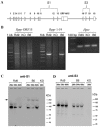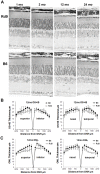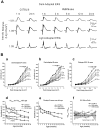Rd9 is a naturally occurring mouse model of a common form of retinitis pigmentosa caused by mutations in RPGR-ORF15
- PMID: 22563472
- PMCID: PMC3341386
- DOI: 10.1371/journal.pone.0035865
Rd9 is a naturally occurring mouse model of a common form of retinitis pigmentosa caused by mutations in RPGR-ORF15
Abstract
Animal models of human disease are an invaluable component of studies aimed at understanding disease pathogenesis and therapeutic possibilities. Mutations in the gene encoding retinitis pigmentosa GTPase regulator (RPGR) are the most common cause of X-linked retinitis pigmentosa (XLRP) and are estimated to cause 20% of all retinal dystrophy cases. A majority of RPGR mutations are present in ORF15, the purine-rich terminal exon of the predominant splice-variant expressed in retina. Here we describe the genetic and phenotypic characterization of the retinal degeneration 9 (Rd9) strain of mice, a naturally occurring animal model of XLRP. Rd9 mice were found to carry a 32-base-pair duplication within ORF15 that causes a shift in the reading frame that introduces a premature-stop codon. Rpgr ORF15 transcripts, but not protein, were detected in retinas from Rd9/Y male mice that exhibited retinal pathology, including pigment loss and slowly progressing decrease in outer nuclear layer thickness. The levels of rhodopsin and transducin in rod outer segments were also decreased, and M-cone opsin appeared mislocalized within cone photoreceptors. In addition, electroretinogram (ERG) a- and b-wave amplitudes of both Rd9/Y male and Rd9/Rd9 female mice showed moderate gradual reduction that continued to 24 months of age. The presence of multiple retinal features that correlate with findings in individuals with XLRP identifies Rd9 as a valuable model for use in gaining insight into ORF15-associated disease progression and pathogenesis, as well as accelerating the development and testing of therapeutic strategies for this common form of retinal dystrophy.
Conflict of interest statement
Figures






Similar articles
-
Codon-Optimized RPGR Improves Stability and Efficacy of AAV8 Gene Therapy in Two Mouse Models of X-Linked Retinitis Pigmentosa.Mol Ther. 2017 Aug 2;25(8):1854-1865. doi: 10.1016/j.ymthe.2017.05.005. Epub 2017 May 24. Mol Ther. 2017. PMID: 28549772 Free PMC article.
-
A long-term efficacy study of gene replacement therapy for RPGR-associated retinal degeneration.Hum Mol Genet. 2015 Jul 15;24(14):3956-70. doi: 10.1093/hmg/ddv134. Epub 2015 Apr 15. Hum Mol Genet. 2015. PMID: 25877300 Free PMC article.
-
Retinal Phenotype in the rd9 Mutant Mouse, a Model of X-Linked RP.Front Neurosci. 2019 Sep 19;13:991. doi: 10.3389/fnins.2019.00991. eCollection 2019. Front Neurosci. 2019. PMID: 31607844 Free PMC article.
-
Mutations of RPGR in X-linked retinitis pigmentosa (RP3).Hum Mutat. 2002 May;19(5):486-500. doi: 10.1002/humu.10057. Hum Mutat. 2002. PMID: 11968081 Review.
-
Clinical characteristics of high myopia in female carriers of pathogenic RPGR mutations: a case series and review of the literature.Ophthalmic Genet. 2023 Jun;44(3):295-303. doi: 10.1080/13816810.2022.2113544. Epub 2022 Aug 26. Ophthalmic Genet. 2023. PMID: 36017691 Free PMC article. Review.
Cited by
-
Biology and therapy of inherited retinal degenerative disease: insights from mouse models.Dis Model Mech. 2015 Feb;8(2):109-29. doi: 10.1242/dmm.017913. Dis Model Mech. 2015. PMID: 25650393 Free PMC article. Review.
-
Retinal Pigment Epithelium Remodeling in Mouse Models of Retinitis Pigmentosa.Int J Mol Sci. 2021 May 20;22(10):5381. doi: 10.3390/ijms22105381. Int J Mol Sci. 2021. PMID: 34065385 Free PMC article.
-
Mutated CCDC51 Coding for a Mitochondrial Protein, MITOK Is a Candidate Gene Defect for Autosomal Recessive Rod-Cone Dystrophy.Int J Mol Sci. 2021 Jul 23;22(15):7875. doi: 10.3390/ijms22157875. Int J Mol Sci. 2021. PMID: 34360642 Free PMC article.
-
RPGR-associated retinal degeneration in human X-linked RP and a murine model.Invest Ophthalmol Vis Sci. 2012 Aug 15;53(9):5594-608. doi: 10.1167/iovs.12-10070. Invest Ophthalmol Vis Sci. 2012. PMID: 22807293 Free PMC article.
-
Optogenetic Gene Therapy for the Degenerate Retina: Recent Advances.Front Neurosci. 2020 Nov 11;14:570909. doi: 10.3389/fnins.2020.570909. eCollection 2020. Front Neurosci. 2020. PMID: 33262683 Free PMC article. Review.
References
-
- Fishman GA, Farber MD, Derlacki DJ. X-linked retinitis pigmentosa: Profile of clinical findings. Arch Ophthalmol. 1988;106:369–375. - PubMed
-
- Shu X, Blac GC, Rice JM, Hart-Holden N, Jones A, et al. RPGR mutation analysis and disease: an update. Hum Mutat. 2007;28:322–328. - PubMed
-
- Vervoort R, Lennon A, Bird AC, Tulloch B, Axton R, et al. Mutational hot spot within a new RPGR exon in X-linked retinitis pigmentosa. Nat Genet. 2000;25:462–466. - PubMed
Publication types
MeSH terms
Substances
Grants and funding
- P60-DK-20572/DK/NIDDK NIH HHS/United States
- R01-EY007758/EY/NEI NIH HHS/United States
- P30-EY07003/EY/NEI NIH HHS/United States
- UL1RR024986/RR/NCRR NIH HHS/United States
- P60 DK020572/DK/NIDDK NIH HHS/United States
- R01 EY007758/EY/NEI NIH HHS/United States
- R01-EY019943/EY/NEI NIH HHS/United States
- R01 EY019943/EY/NEI NIH HHS/United States
- UL1 RR024986/RR/NCRR NIH HHS/United States
- R01 EY007961/EY/NEI NIH HHS/United States
- ImNIH/Intramural NIH HHS/United States
- P30 EY007003/EY/NEI NIH HHS/United States
- R01-EY007961/EY/NEI NIH HHS/United States
LinkOut - more resources
Full Text Sources
Other Literature Sources
Molecular Biology Databases

